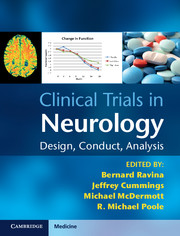Crossref Citations
This Book has been
cited by the following publications. This list is generated based on data provided by Crossref.
Beran, R. G.
Stepanova, D.
and
Beran, M. E.
2016.
Justification for conducting neurological clinical trials as part of patient care within private practice.
International Journal of Clinical Practice,
Vol. 70,
Issue. 5,
p.
365.
Swallow, Elyse
Fang, Anna
Signorovitch, James
Plumb, Jonathan
and
Borghs, Simon
2017.
Can Matching-Adjusted Indirect Comparison Methods Mitigate Placebo Response Differences Among Patient Populations in Adjunctive Trials of Brivaracetam and Levetiracetam?.
CNS Drugs,
Vol. 31,
Issue. 10,
p.
899.
Jones, Felipe
and
Fregni, Felipe
2018.
Clinical Trials in Neurology.
Vol. 138,
Issue. ,
p.
213.
Shan, Guogen
Banks, Sarah
Miller, Justin B.
Ritter, Aaron
Bernick, Charles
Lombardo, Joseph
and
Cummings, Jeffrey L.
2018.
Statistical advances in clinical trials and clinical research.
Alzheimer's & Dementia: Translational Research & Clinical Interventions,
Vol. 4,
Issue. 1,
p.
366.
Stavale, Rafaelly
Jones, Felipe
Malavera, Alejandra
and
Fregni, Felipe
2018.
Clinical Trials in Neurology.
Vol. 138,
Issue. ,
p.
399.
Karanth, Shama
Nelson, Peter T.
Katsumata, Yuriko
Kryscio, Richard J.
Schmitt, Frederick A.
Fardo, David W.
Cykowski, Matthew D.
Jicha, Gregory A.
Van Eldik, Linda J.
and
Abner, Erin L.
2020.
Prevalence and Clinical Phenotype of Quadruple Misfolded Proteins in Older Adults.
JAMA Neurology,
Vol. 77,
Issue. 10,
p.
1299.
Moinuddin, Omar
Khandwala, Nikhila S.
Young, Kelly Z.
Sathrasala, Sanjana K.
Barmada, Sami J.
Albin, Roger L.
and
Besirli, Cagri G.
2021.
Role of Optical Coherence Tomography in Identifying Retinal Biomarkers in Frontotemporal Dementia.
Neurology Clinical Practice,
Vol. 11,
Issue. 4,



